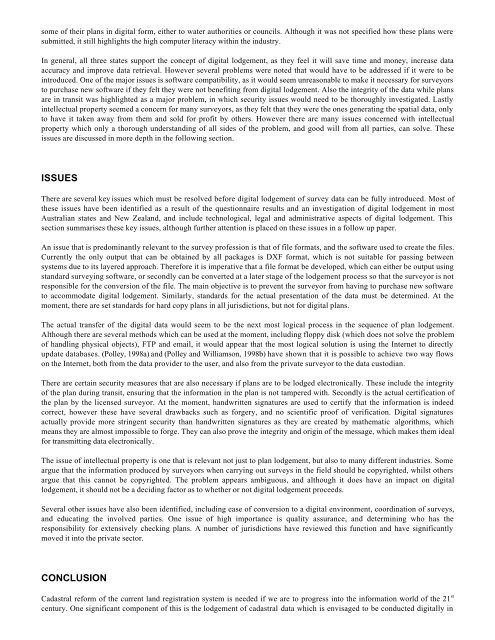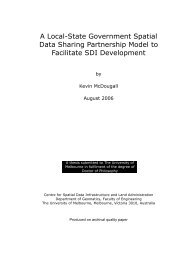Digital Lodgement of Cadastral Survey Data in Australia - Centre for ...
Digital Lodgement of Cadastral Survey Data in Australia - Centre for ...
Digital Lodgement of Cadastral Survey Data in Australia - Centre for ...
Create successful ePaper yourself
Turn your PDF publications into a flip-book with our unique Google optimized e-Paper software.
some <strong>of</strong> their plans <strong>in</strong> digital <strong>for</strong>m, either to water authorities or councils. Although it was not specified how these plans were<br />
submitted, it still highlights the high computer literacy with<strong>in</strong> the <strong>in</strong>dustry.<br />
In general, all three states support the concept <strong>of</strong> digital lodgement, as they feel it will save time and money, <strong>in</strong>crease data<br />
accuracy and improve data retrieval. However several problems were noted that would have to be addressed if it were to be<br />
<strong>in</strong>troduced. One <strong>of</strong> the major issues is s<strong>of</strong>tware compatibility, as it would seem unreasonable to make it necessary <strong>for</strong> surveyors<br />
to purchase new s<strong>of</strong>tware if they felt they were not benefit<strong>in</strong>g from digital lodgement. Also the <strong>in</strong>tegrity <strong>of</strong> the data while plans<br />
are <strong>in</strong> transit was highlighted as a major problem, <strong>in</strong> which security issues would need to be thoroughly <strong>in</strong>vestigated. Lastly<br />
<strong>in</strong>tellectual property seemed a concern <strong>for</strong> many surveyors, as they felt that they were the ones generat<strong>in</strong>g the spatial data, only<br />
to have it taken away from them and sold <strong>for</strong> pr<strong>of</strong>it by others. However there are many issues concerned with <strong>in</strong>tellectual<br />
property which only a thorough understand<strong>in</strong>g <strong>of</strong> all sides <strong>of</strong> the problem, and good will from all parties, can solve. These<br />
issues are discussed <strong>in</strong> more depth <strong>in</strong> the follow<strong>in</strong>g section.<br />
ISSUES<br />
There are several key issues which must be resolved be<strong>for</strong>e digital lodgement <strong>of</strong> survey data can be fully <strong>in</strong>troduced. Most <strong>of</strong><br />
these issues have been identified as a result <strong>of</strong> the questionnaire results and an <strong>in</strong>vestigation <strong>of</strong> digital lodgement <strong>in</strong> most<br />
<strong>Australia</strong>n states and New Zealand, and <strong>in</strong>clude technological, legal and adm<strong>in</strong>istrative aspects <strong>of</strong> digital lodgement. This<br />
section summarises these key issues, although further attention is placed on these issues <strong>in</strong> a follow up paper.<br />
An issue that is predom<strong>in</strong>antly relevant to the survey pr<strong>of</strong>ession is that <strong>of</strong> file <strong>for</strong>mats, and the s<strong>of</strong>tware used to create the files.<br />
Currently the only output that can be obta<strong>in</strong>ed by all packages is DXF <strong>for</strong>mat, which is not suitable <strong>for</strong> pass<strong>in</strong>g between<br />
systems due to its layered approach. There<strong>for</strong>e it is imperative that a file <strong>for</strong>mat be developed, which can either be output us<strong>in</strong>g<br />
standard survey<strong>in</strong>g s<strong>of</strong>tware, or secondly can be converted at a later stage <strong>of</strong> the lodgement process so that the surveyor is not<br />
responsible <strong>for</strong> the conversion <strong>of</strong> the file. The ma<strong>in</strong> objective is to prevent the surveyor from hav<strong>in</strong>g to purchase new s<strong>of</strong>tware<br />
to accommodate digital lodgement. Similarly, standards <strong>for</strong> the actual presentation <strong>of</strong> the data must be determ<strong>in</strong>ed. At the<br />
moment, there are set standards <strong>for</strong> hard copy plans <strong>in</strong> all jurisdictions, but not <strong>for</strong> digital plans.<br />
The actual transfer <strong>of</strong> the digital data would seem to be the next most logical process <strong>in</strong> the sequence <strong>of</strong> plan lodgement.<br />
Although there are several methods which can be used at the moment, <strong>in</strong>clud<strong>in</strong>g floppy disk (which does not solve the problem<br />
<strong>of</strong> handl<strong>in</strong>g physical objects), FTP and email, it would appear that the most logical solution is us<strong>in</strong>g the Internet to directly<br />
update databases. (Polley, 1998a) and (Polley and Williamson, 1998b) have shown that it is possible to achieve two way flows<br />
on the Internet, both from the data provider to the user, and also from the private surveyor to the data custodian.<br />
There are certa<strong>in</strong> security measures that are also necessary if plans are to be lodged electronically. These <strong>in</strong>clude the <strong>in</strong>tegrity<br />
<strong>of</strong> the plan dur<strong>in</strong>g transit, ensur<strong>in</strong>g that the <strong>in</strong><strong>for</strong>mation <strong>in</strong> the plan is not tampered with. Secondly is the actual certification <strong>of</strong><br />
the plan by the licensed surveyor. At the moment, handwritten signatures are used to certify that the <strong>in</strong><strong>for</strong>mation is <strong>in</strong>deed<br />
correct, however these have several drawbacks such as <strong>for</strong>gery, and no scientific pro<strong>of</strong> <strong>of</strong> verification. <strong>Digital</strong> signatures<br />
actually provide more str<strong>in</strong>gent security than handwritten signatures as they are created by mathematic algorithms, which<br />
means they are almost impossible to <strong>for</strong>ge. They can also prove the <strong>in</strong>tegrity and orig<strong>in</strong> <strong>of</strong> the message, which makes them ideal<br />
<strong>for</strong> transmitt<strong>in</strong>g data electronically.<br />
The issue <strong>of</strong> <strong>in</strong>tellectual property is one that is relevant not just to plan lodgement, but also to many different <strong>in</strong>dustries. Some<br />
argue that the <strong>in</strong><strong>for</strong>mation produced by surveyors when carry<strong>in</strong>g out surveys <strong>in</strong> the field should be copyrighted, whilst others<br />
argue that this cannot be copyrighted. The problem appears ambiguous, and although it does have an impact on digital<br />
lodgement, it should not be a decid<strong>in</strong>g factor as to whether or not digital lodgement proceeds.<br />
Several other issues have also been identified, <strong>in</strong>clud<strong>in</strong>g ease <strong>of</strong> conversion to a digital environment, coord<strong>in</strong>ation <strong>of</strong> surveys,<br />
and educat<strong>in</strong>g the <strong>in</strong>volved parties. One issue <strong>of</strong> high importance is quality assurance, and determ<strong>in</strong><strong>in</strong>g who has the<br />
responsibility <strong>for</strong> extensively check<strong>in</strong>g plans. A number <strong>of</strong> jurisdictions have reviewed this function and have significantly<br />
moved it <strong>in</strong>to the private sector.<br />
CONCLUSION<br />
<strong>Cadastral</strong> re<strong>for</strong>m <strong>of</strong> the current land registration system is needed if we are to progress <strong>in</strong>to the <strong>in</strong><strong>for</strong>mation world <strong>of</strong> the 21 st<br />
century. One significant component <strong>of</strong> this is the lodgement <strong>of</strong> cadastral data which is envisaged to be conducted digitally <strong>in</strong>







